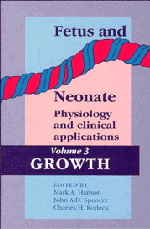Book contents
- Frontmatter
- Contents
- Preface to the series
- List of contributors
- Part I Physiology
- Part II Pathophysiology
- 6 Experimental restriction of fetal growth
- 7 Placental changes in fetal growth retardation
- 8 Human fetal blood gases, glucose, lactate and amino acids in IUGR
- 9 Glucose and fetal growth derangement
- 10 Fetal programming of human disease
- Part III Clinical applications
- Index
9 - Glucose and fetal growth derangement
from Part II - Pathophysiology
Published online by Cambridge University Press: 04 August 2010
- Frontmatter
- Contents
- Preface to the series
- List of contributors
- Part I Physiology
- Part II Pathophysiology
- 6 Experimental restriction of fetal growth
- 7 Placental changes in fetal growth retardation
- 8 Human fetal blood gases, glucose, lactate and amino acids in IUGR
- 9 Glucose and fetal growth derangement
- 10 Fetal programming of human disease
- Part III Clinical applications
- Index
Summary
Introduction
Fetal growth derangement is associated with abnormalities in the regulation of both maternal and fetal glucose homeostasis in many situations. The classic clinical example is the fetal macrosomia which frequently accompanies poor control of maternal diabetes, especially in the latter half of gestation (Metzger, 1991). It is equally evident, however, from the dramatic 30–70% reduction in the rate of increase of fetal girth and crown–rump length measurements which occurs in fetal lambs within 3 days of reducing maternal plasma glucose by severe undernutrition in late pregnancy (Mellor, 1984). Fetal hypoglycaemia is also observed in intrauterine growth retardation (IUGR) (Economides, Nicolaides & Campbell, 1991) and in many experimental models of fetal growth retardation (see Chapter 6 by Owens, Owens & Robinson). The delivery of glucose to the uterus therefore plays a very important role in determining the rate of fetal growth, but why should this be so?
The vital role of glucose as an essential substrate for oxidative metabolism in fetal tissues is well known (Battaglia & Meschia, 1978), but it is very unlikely that the rate of fetal tissue growth will depend in any simple way on the rate of glucose delivery to the conceptus. The programmed differential growth of organs and tissues within the conceptus from the earliest stages of embryogenesis makes it far more likely that mechanisms exist to regulate the delivery and availability of glucose and other substrates to meet the differing needs of these individual tissues.
- Type
- Chapter
- Information
- Fetus and Neonate: Physiology and Clinical Applications , pp. 223 - 254Publisher: Cambridge University PressPrint publication year: 1995
- 1
- Cited by



